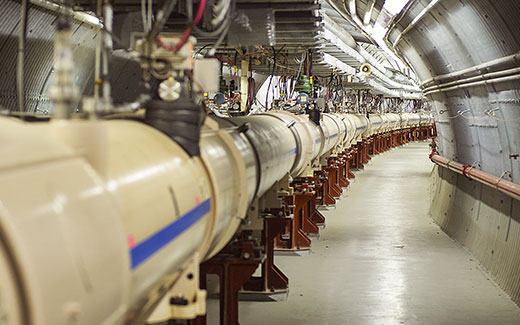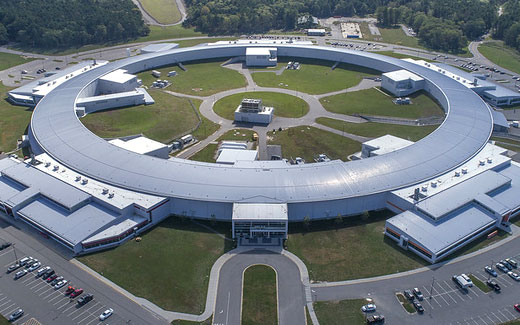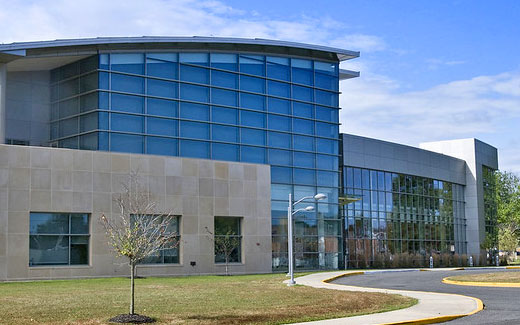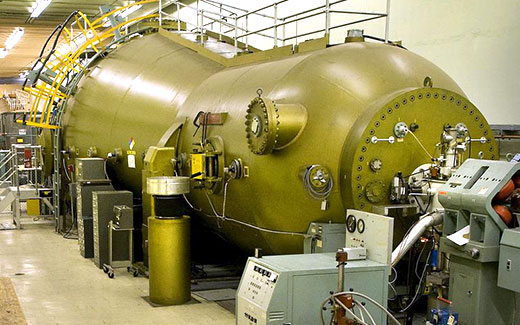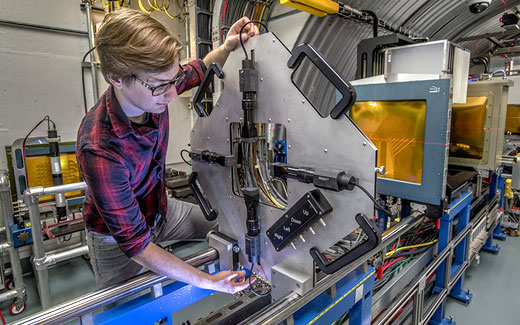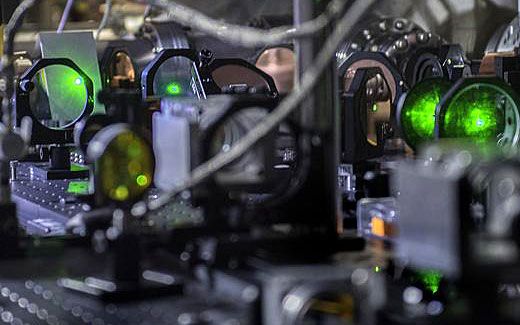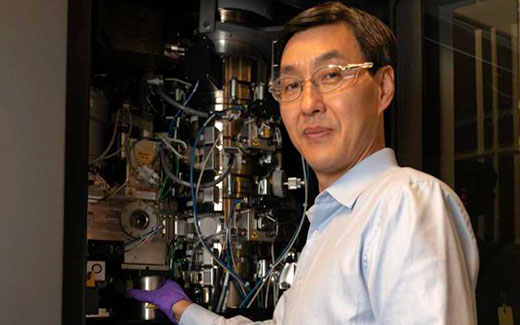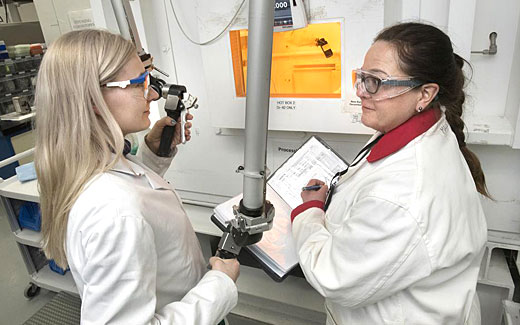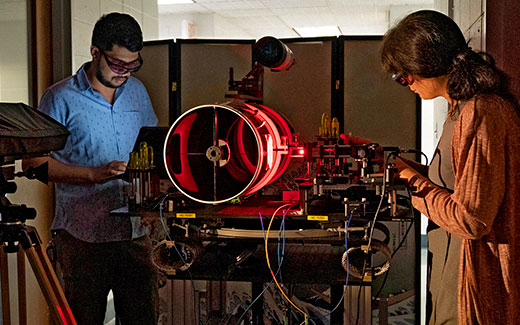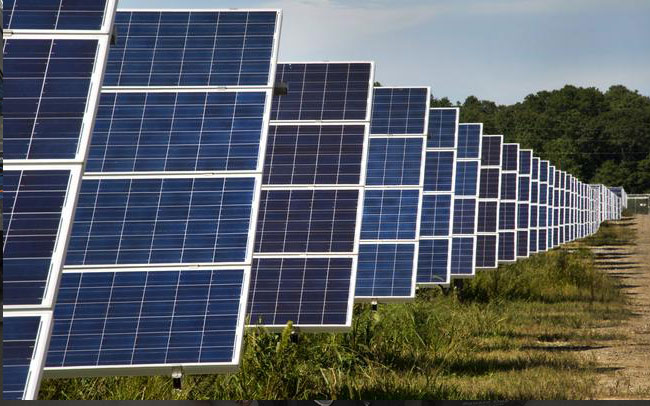
Brookhaven National Lab excels at the design, construction, and operation of large-scale, cutting-edge research facilities—some available nowhere else in the world. Each year, thousands of scientists from laboratories, universities, and industries around the world use these facilities to delve into the basic mysteries of physics, chemistry, biology, materials science, energy, and the environment—and develop innovative applications that arise, sometimes at the intersections of these disciplines.
The Relativistic Heavy Ion Collider (RHIC) smashes particles together to recreate the conditions of the early universe so scientists can explore the most fundamental building blocks of matter as they existed just after the Big Bang. This research unlocks secrets of the force that holds together 99 percent of the visible universe—everything from stars to planets and people—and triggers advances in science and technology that have applications in fields from medicine to national security. More than 1,000 scientists from around the globe—including hundreds of students training to be part of our nation’s future high-tech workforce—conduct research at RHIC.
The National Synchrotron Light Source II (NSLS-II) generates intense beams of x-ray, ultraviolet, and infrared light and offers an array of sophisticated imaging techniques to capture atomic-level “pictures” of a wide variety of materials, from biological molecules to semiconductor devices. NSLS-II has a nanometer-scale resolution—a key resource for researchers at Brookhaven’s CFN—and enhances the development of next-generation sustainable energy technologies and improves imaging of complex protein structures.
The Center for Functional Nanomaterials (CFN)—one of five Nanoscale Science Research Centers funded by the Department of Energy’s Office of Science—provides state-of-the-art tools for creating and exploring the properties of materials with dimensions spanning just billionths of a meter. CFN scientists are dedicated to atomic-level tailoring that addresses a wide range of energy challenges. CFN focus areas include: improving solar cells and other electronic nanomaterials; designing more efficient catalysts; developing new capabilities and uses for electron microscopy; nanofabrication based on soft and biological nanomaterials—all aided by theory and advanced computation.
The Tandem Van de Graaff facility, a large electrostatic accelerator, can provide researchers with beams of more than 40 different types of ions — atoms that have been stripped of their electrons. Ions ranging from hydrogen to uranium are available. The facility consists of two 15 million volt electrostatic accelerators aligned end-to-end. One application for the Tandem is the testing of integrated circuit chips under heavy ion bombardment. By simulating the effects of radiation both in space and on the ground, engineers are improving the reliability of computers.
The NASA Space Radiation Laboratory (NSRL) uses beams of heavy ions from the accelerators that feed RHIC to simulate space radiation and study its effects on biological specimens—such as cells, tissues, and DNA—and industrial materials. The National Aeronautic and Space Administration (NASA) and the DOE Office of Science partnered to build NSRL to identify materials and methods that reduce the risks astronauts will face on future long-term space missions.
The Accelerator Test Facility (ATF) is designed to explore new methods of accelerating particles to higher energies and producing ever-brighter x-ray beams. Research conducted by scientists from Brookhaven and other institutions has implications for both physics research and future medical applications, including new cancer-treatment systems. The core capabilities of the ATF include a high-brightness photoinjector electron gun, a 70 million electron-volt linear accelerator, high power lasers synchronized to the electron beam with picosecond precision, and four beam lines.
The Laboratory for BioMolecular Structure (LBMS) is a state-of-the-art center for life science imaging located at Brookhaven National Laboratory. The center offers access to state-of-the-art cryo-electron microscopes and laboratory equipment for studies on the building blocks of all living organisms and their behavior.
The Brookhaven Linac Isoptope Producer (BLIP) produces commercially unavailable radioisotopes for use by the medical community and related industries. BLIP consists of a an accelerator beam line and target area for generating radioisotopes already in high demand and for developing those required at the frontiers of nuclear medicine. In conjunction with this mission, scientists also perform irradiations for non-isotope applications and explore opportunities for emerging radioisotope applications.
Brookhaven Lab is building the world's first polarized electron-proton/ion collider, known as the Electron-Ion Collider (EIC). This discovery machine will unlock the secrets of the “glue” that binds the building blocks of visible matter. By colliding electrons with protons and nuclei, the EIC will produce snapshots of those particles’ internal structure—like a CT scanner for atoms. Beyond sparking scientific discoveries in a new frontier of nuclear physics, the EIC will trigger technological breakthroughs with broad-ranging impact, from human health to national security.
The Quantum Network Facility is open to the user community. Experimental opportunities are focused on the development of foundational quantum devices, including entanglement generation and detection, and characterization of quantum memories with a focus on scalability. The facility provides the possibility to integrate these building blocks with existing real-life inter-city fibers and characterize their performance at the network level.
The Northeast Solar Energy Research Center (NSERC), located on the Brookhaven Lab campus, serves as a solar energy research and test facility for the solar industry. NSERC includes laboratories for standardized testing in accordance with industry standards, along with a solar PV research array for field testing existing or innovative new technologies under actual northeastern weather conditions. NSERC includes access to unique high-resolution data sets from the 32MW Long Island Solar Farm located at Brookhaven.




